NACE Journal, February 2020
Qualitative and quantitative research shows that what constitutes a co-op varies.
Over time, cooperative education (also referred to as co-op/co-ops) has gained wide adoption in practice. Although the term “cooperative education” is used at many institutions, no generally accepted definition for this type of experiential education for higher education students exists. Co-op programs vary greatly in myriad ways.
In the spring of 2019, a call was put forth at University of Nebraska-Lincoln (UNL) to research how institutions define and manage cooperative education experiences. Through quantitative surveying and qualitative interviewing, research was done to answer the question “What is cooperative education?”
Literature Review
Since the development of cooperative education by the University of Cincinnati (UC) in 1906, the practice has spread worldwide. With such broad dissemination, one may assume there is a singular and well-specified definition for co-op, but this proves not so, leading one to question: What is co-op? A review of the literature investigated the definition and distinguishing factors of cooperative education.
One group defines co-op as “an educational methodology in which periods of classroom instruction alternate with periods of paid discipline-related work experience. Co-op students typically participate in a school-work rotation that may span over as many as three academic years throughout their undergraduate education.”1 In comparing this definition to others, however, there are obvious differences. Philip Gardner and Kenneth Barkus noted that “it is difficult to clearly understand the distinction between cooperative education and other models of delivering a work/education experience.”2 (See Figure 1.)
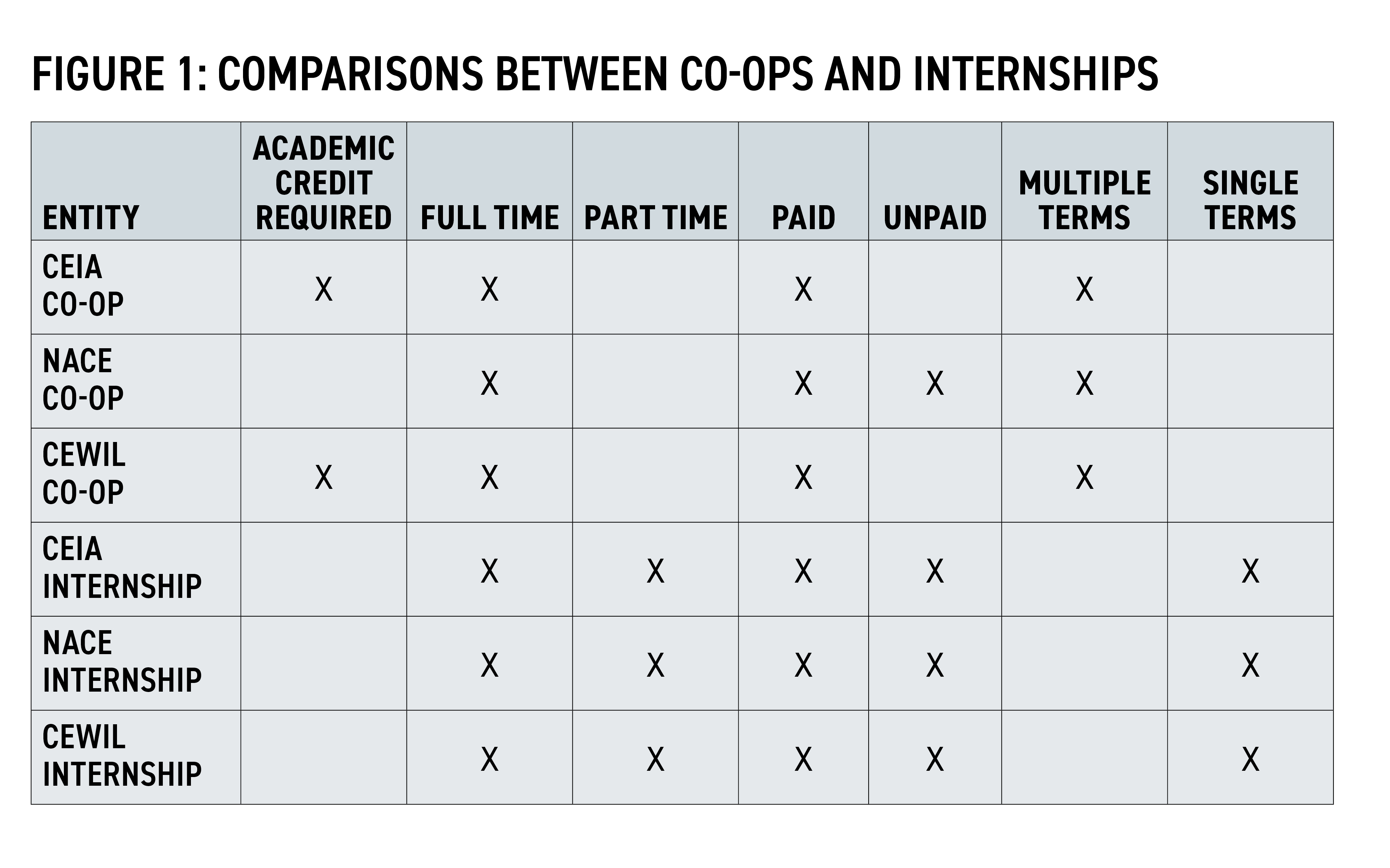
Themes in the literature helped break down and differentiate among the definitions. This includes time commitment and rotational cycles; progression of students in their work; remuneration; academic credit; and the relationships among institution, employer, and student.
Time commitments of co-ops and their rotations vary greatly. In addition, although the idea in general of alternating time periods is clear in various definitions, it is not among organizations that give guidance to practitioners (hereafter “guiding organizations”). The Cooperative Education and Internship Association (CEIA) notes that, “co-op experiences are either full-time (40 hours per week) alternating periods (semester, quarter) of work and school or part-time (20 hours per week) combining work and school during the same time period.”3 NACE relates that “the typical program plan is for students to alternate terms of full-time classroom study with terms of full-time, discipline-related employment. Since the program participation involves multiple work terms, the typical participant will work three or four work terms, thus gaining a year or more of career-related work experience before graduation.”4 Finally, Co-operative Education and Work-Integrated Learning (CEWIL) of Canada says “the usual plan is for the student to alternate periods of study with periods of work experience in appropriate fields of business, industry, government, social services, and the professions” without alluding to length of terms.5
The literature also suggests differences in work progression for students in co-ops. At one college, students were encouraged to work with multiple employers and spend no more than 26 weeks with any one organization, though some students work for only one over the course of their education.6 Several pieces of the literature describe students as having all rotations through one employer, during which the student progresses in role responsibility.7 Another suggests that students cycle through workplace departments to experience various functions of an organization.8 Both CEIA and NACE suggest no specific outline of employment progression.
Throughout the literature, the idea that work should be paid is consistent. Co-op programs can be mandatory or optional (and UC offers degree programs with a mandatory co-op component, including various engineering and science degrees, as well as others in which co-op is optional), but research suggests that even when it is optional, the “academically stronger students typically gravitate toward co-op.”9
Finally, co-op exists across institutions as integrations or relationships of institution, employer, and student that range across a spectrum from transactional to true partnership. On the transactional end, employers and institutions do not work with each other, having only the student as the tie between the two. On the other end of this spectrum are institutions that develop the program alongside the employer and create a strong, reciprocal relationship.
Though co-ops may share some attributes, the details of these attributes differ from experience to experience, institution to institution, and guiding association to guiding association.
Qualitative Research Into Co-op Programs
Qualitative research methodology was used to learn what components exist among and between co-op programs at four-year higher education institutions. Three experienced director-level practitioners from career services offices at four-year institutions in the United States were identified for participation. Semi-structured phone interviews were conducted with all three participants, and additional follow-up questions were answered via email. Other qualitative documents were also collected via email, including program outlines and descriptions. The interview process consisted of seven unstructured, open-ended questions. Prompts were used to gain additional insight, and participants were invited to share additional information they felt was valuable in respect to the research topic.
Findings
In noting their connection to co-op at their institution, each interviewee commented on the roles career development professionals and university faculty played. The level of involvement of the academic department seemed to indicate the level of assessment of co-op. Two participants reported that co-ops are managed at the faculty level, while the third reported the program is run through and managed by career services. For the two who played roles secondary to faculty, there seemed to be a gap in assessment of student outcomes. For these participants, the reflection on benefits and outcomes for students came from word-of-mouth feedback and anecdotal evidence gleaned from post-experience student interactions. The practitioner whose office managed the co-op program had much greater certainty about outcomes.
Participants detailed components and requirements for co-ops at their institutions, which differed greatly from one another. These included whether co-ops were or should be required for programs, how long they should be either by term (quarter, semester, or multi-term) or by hours worked, how many hours should be worked per week by students, what homework or coursework accompanies co-ops, and at what time in their academic career students should undertake co-ops. Each noted the lack of a consistent, accepted definition and indicated a preference for clearer expectations from a governing body or professional association, though each reported adopting standards from different bodies.
There were commonalities across the three programs: The participants reported that co-ops are represented on student transcripts, that students can take time off of school to participate in the co-op with no negative impact on their financial aid eligibility or full-time student status, and that co-ops are always paid. All three also provided reflection points for the students and evaluation.
Clear differences between programs arose when considering which students undertake co-ops, timing, and hours-worked requirements. Participants detailed a variety of majors, year and school, and efficacy levels that help them identify to which students to offer co-op. In addition, whilegoal setting and preparation were part of the program requirements for all three, the depth of the goal setting and preparation differed.
Each of the three participants noted that cooperative education affects relationships among and between students, employers, and institutions.
The qualitative research illustrated that cooperative education can be structured and managed in different ways. Among participants’ institutions, only one maintained a singular co-op program for the university that was managed by career services, with career services providing advice, preparation, marketing, and experience tracking. The participant from this institution described a robust program that was created to be consistent for students across the university. For this individual, the program was “one of the heart beats” of the career services office. In addition, the office was directly connected to the assessment of co-ops.
The other participants were less involved and aware of program specifics, such as the management standards for the program, but were involved in preparatory work in the way of career competency development, application materials assistance and review, and preparatory workshops and seminars. In addition, their understanding of outcomes was less distinct and more anecdotal.
While the literature strongly suggested rotational or advancing cycles for co-ops, none of the participants reflected this in their interviews. There was no reiterative requirement described by any of the participants. One did say that co-ops typically take place over multiple semesters, though these may be back-to-back or can have a break in between.
Each program has different time requirements and/or standards. One program required students to work a minimum of 320 hours over the course of a 16-week semester, or about 20 hours per work. Another required students to work full time for a quarter (half a semester); the third allowed students to work as few as 20 hours and up to 40 hours per week for the length of the experience. The number of hours worked was strongly connected to the credit components for co-ops. At one institution, students who were considered working full time did not simultaneously take any other courses. The other two programs had different rules: In one case, working 20 hours per week was sufficient, and the student did not need to take additional courses. In the other case, students were able to take online classes. Identifying this component is essential for co-op programs: Student financial aid and part- or full-time status depend on how many credits a student takes.
There was agreement across all three regarding credit (co-op carries course credit) and renumeration (co-ops are paid). Finally, participants agreed that co-op benefitted relationships among students, the institution, and employers.
Quantitative Review of Co-op Programs
Quantitative data were collected from professionals in the field of experiential learning/co-ops via survey, and follow-up inquiries were made to add to the research. The group surveyed included members of CEIA and members of the Hire Big 10+ Consortium—a network of career services professionals from Big 10 schools as well as DePaul University, University of Chicago, and University of Notre Dame. Survey respondents included experiential learning and career preparation professionals from across the United States, as well as faculty and staff involved in the teaching and/or management of experiential learning programs.
A total of 53 responded; of these, 38 reported their institutions offer cooperative education to their students. By position/role, 21 percent of these were program managers/coordinators; 32 percent were associate/assistant directors; 35 percent were directors/deans; 5 percent were faculty members; and 4 percent were advisers. (Three percent did not provide role information.)
The institutions reporting showed a broad spectrum of attributes, with institution types including 61 percent public and 39 percent private, and all sizes of institutions represented (29.5 percent were from institutions with undergraduate enrollments of less than 5,000; 13.6 percent were at schools with undergraduate enrollments of 5,000 to 15,000; and 56.8 percent represented institutions with undergraduate enrollments exceeding 15,000). The sample included respondents from institutions in 20 states across the country.
These 38 individuals reported that co-ops fell into three categories for management: centrally managed by the university, managed at the college level, and program-managed within their major/area by faculty or staff. (See Figure 2.)
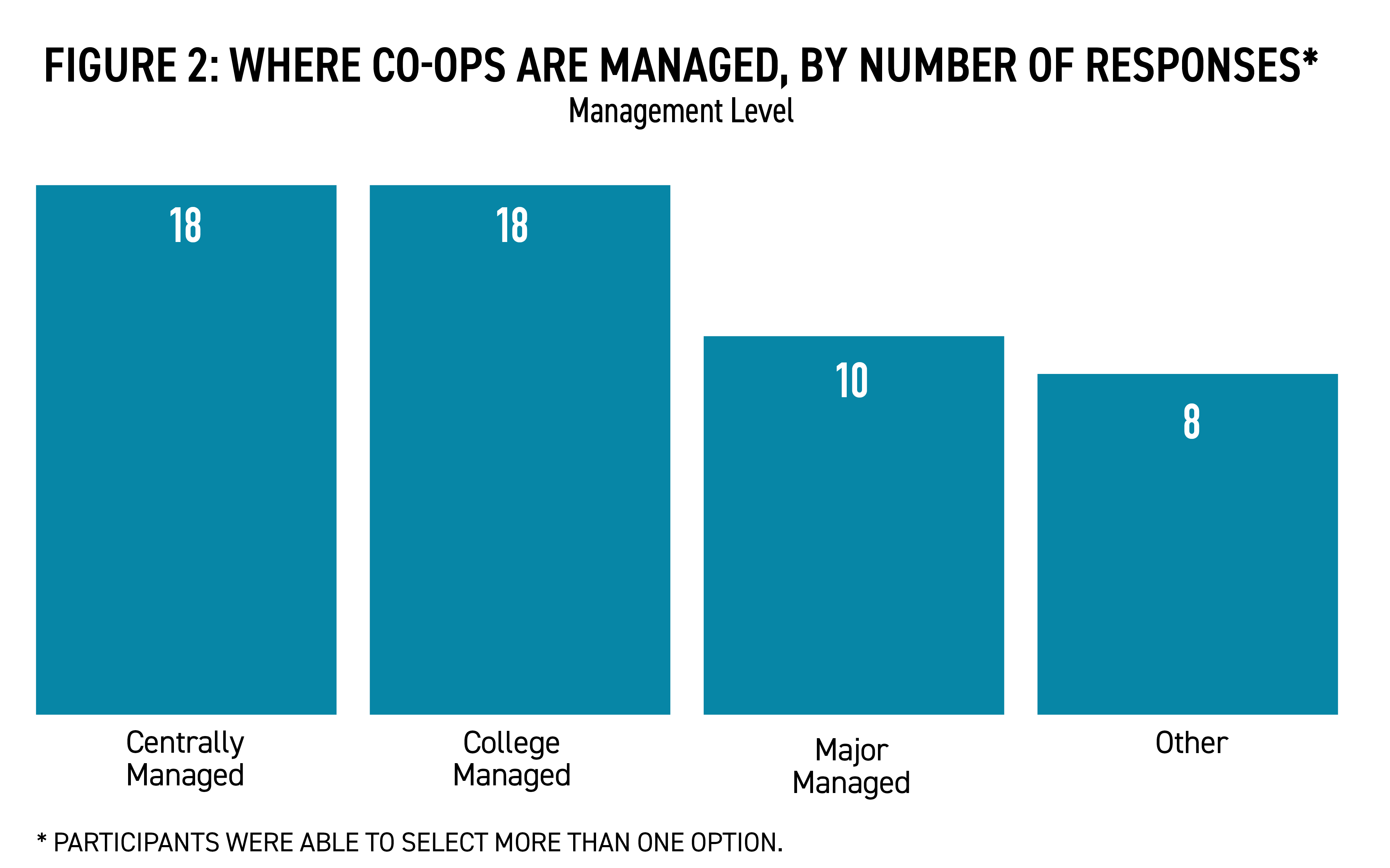
Definitions for co-ops and cooperative education ranged widely, especially when distinguishing co-ops from internships. Key distinguishing factors included the timing and length of the experience, number of placements, credit awarded, hours worked, status distinction (full/part time), concurrent coursework, structure and learning, and pay.
Timing and length: Timing varies by institution, but seems to be one of the main bases for distinguishing co-ops from internships. All respondents agree that length of experience is a distinguishing factor of co-ops, with institutions making unique decisions on where that distinction lies. Many indicated that co-op requires a student to work at least two terms that are often consecutive, e.g., summer/fall, fall/spring, and spring/summer, though some institutions create a schedule by which the students rotate alternating terms, e.g., summer/spring, fall/summer, and spring/fall. Some institutions require two terms, while others require three or more over the course of the student’s academic career.
In contrast to this, internships were often described as shorter term or variable in length at the discretion of the student or employer.
Number of placements: A majority of institutions indicated that they require that students in co-ops undertake multiple (two or more) experiences during their academic careers. However, some institutions indicated that one experience was acceptable.
Pay: Most respondents reported that cooperative education should only be paid. Those who indicated accepting unpaid co-ops typically indicated that internships and co-ops are interchangeable at their institutions and most often the experiences are paid.
Credit awarded: For co-ops, credit is awarded, even if only in a 0-credit capacity to show student activity.
Hours worked: Hours worked varies widely across respondent data, though a majority include a requirement for hours worked for the experience to count for credit or to be considered legitimate experiential learning.
Status distinction: Depending on program structure, respondents sometimes accepted only full-time experiences as co-ops, while others accepted full- or part-time experiences. When full time, students typically enroll in a course component ranging from 0 to 16 credits to maintain full-time student status. Credits are awarded by hours worked. When part time, students typically enroll in regular coursework up to 12 credits plus a course component from 0 to 12 credits to maintain full-time student status. Status distinction is often affected by the structure of the program in whether the student takes on experiences in consecutive or alternating terms.
Coursework, structure, and learning: Most respondents reported that there should be a curricular component to co-ops. This could be through coursework required during the experience, or through pre- or post-experience required courses.
Other: Several respondents indicated a move to consider internships and co-ops under the same umbrella, with co-ops indistinguishable from internships.
Curricular, Syllabus, and Transcript Components
Of the 38 respondents who indicated offering co-ops through their institutions, an overwhelming majority indicated that a curricular component is included. (See Figure 3.) Of note: Respondents reported that the curricular component varies; it may be reflected by a required co-op preparatory course, concurrent coursework/curriculum, or a mix of both. Two-thirds reported that there is a syllabus for the co-op.
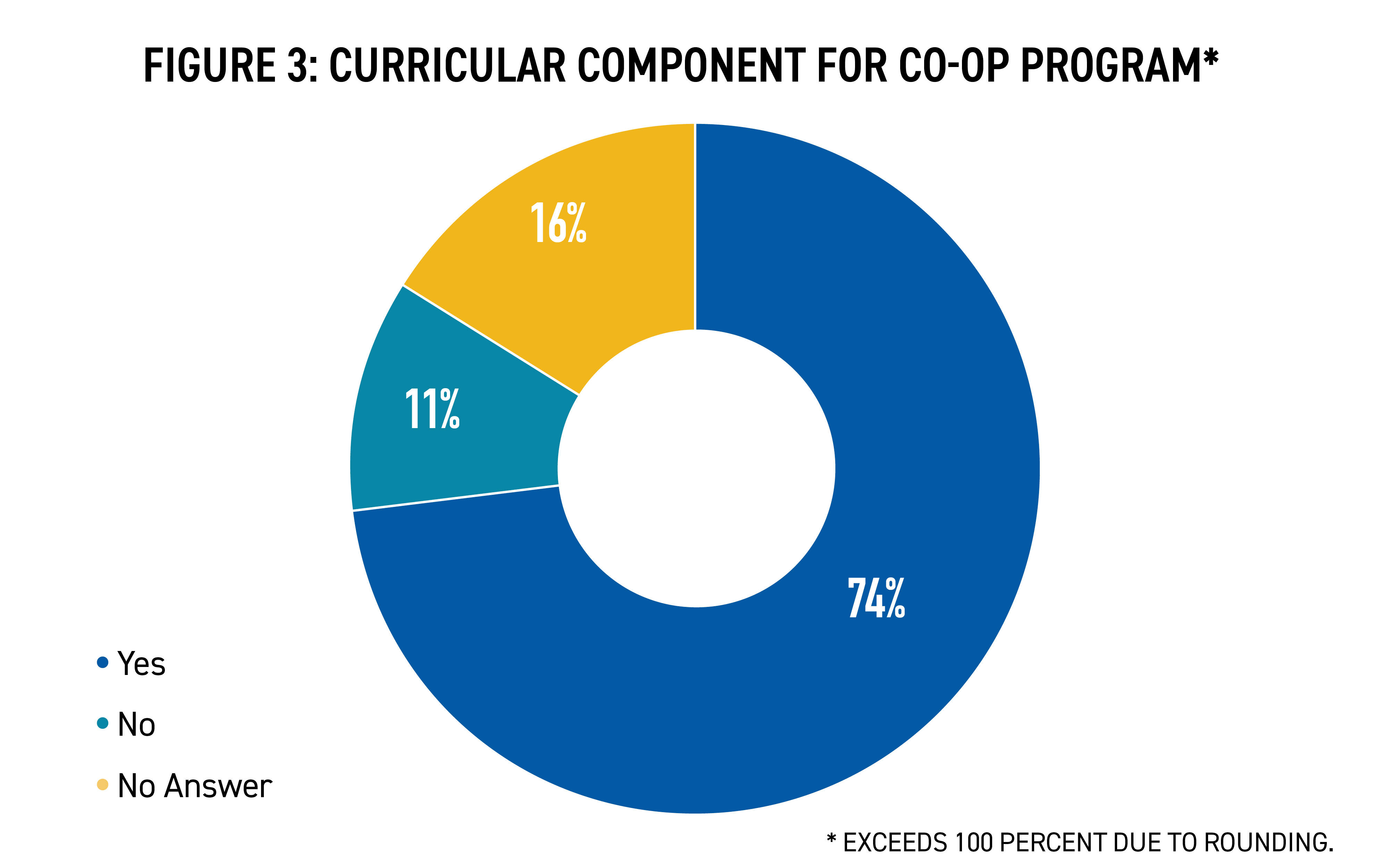
The majority indicated that co-ops appear on transcripts (see Figure 4); those who responded that co-ops are not on the transcript at their institutions indicated that this is because there is not a mechanism for doing so.
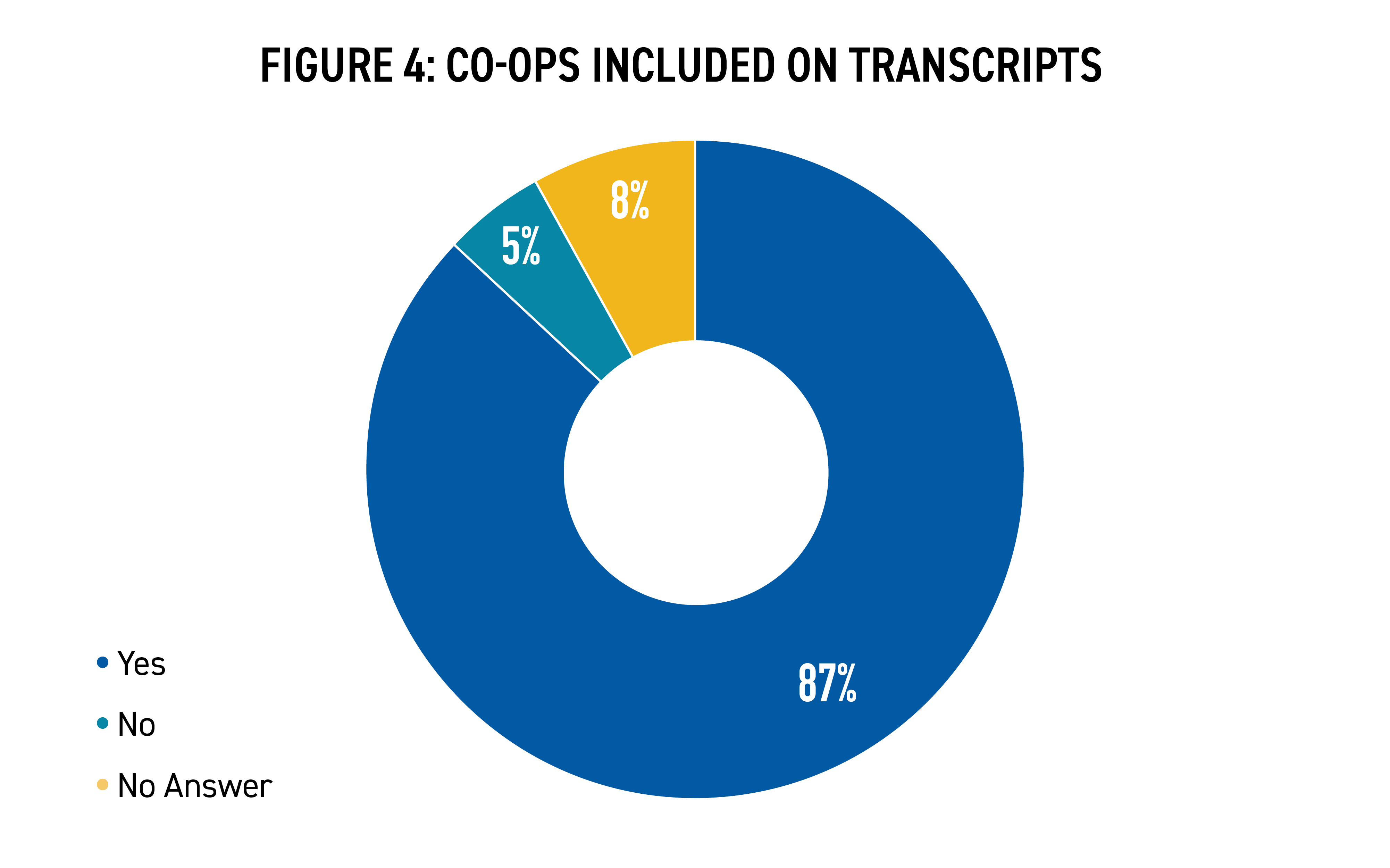
Seventy-one percent of respondents indicated that their intuitions require cooperative education experiences to be paid, while 26 percent indicated that they allow either paid or unpaid. (See Figure 5.)
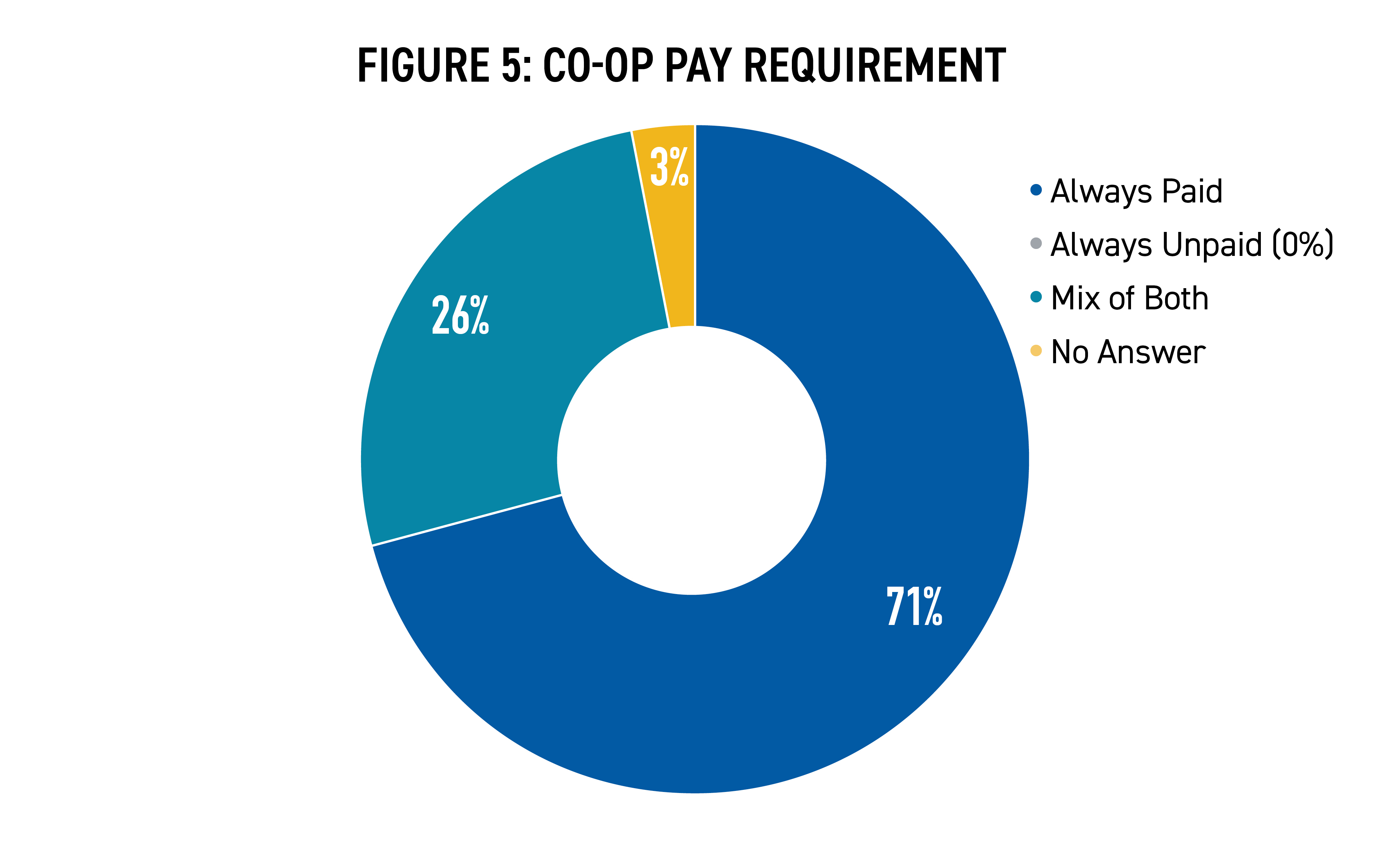
In addition, 42 percent responded that work must be full time to be considered a co-op. (See Figure 6.)
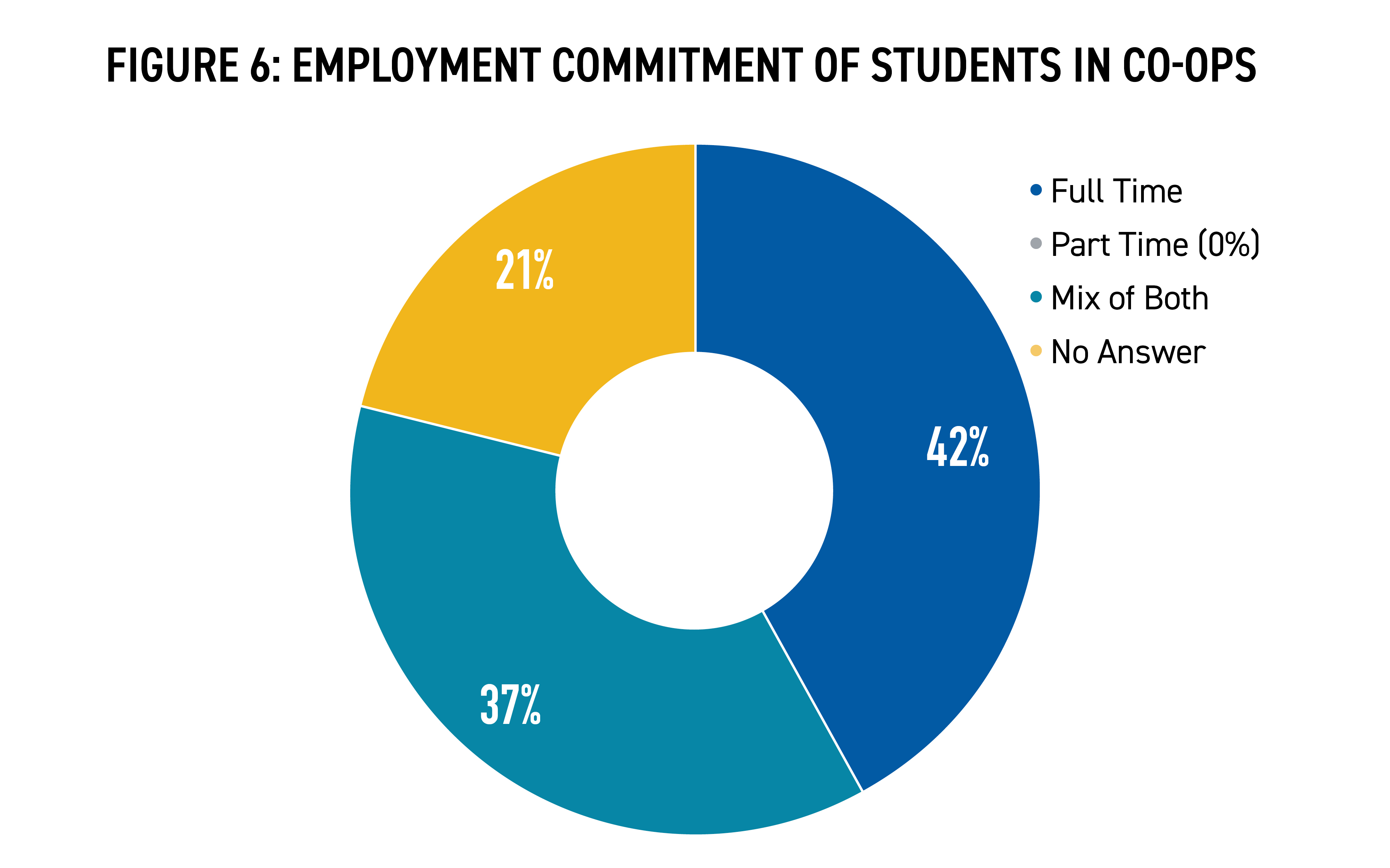
Other parameters that were indicated included not a full-time or part-time status, but rather an hours requirement over the term of the experience. For example, one parameter noted was a requirement of 36 work hours per credit hour awarded, while another indicated that 690 work hours must be completed over the course of 23 weeks.
Implementing and Managing Co-ops
Colleges and universities often create their own definitions for co-ops, but it is clear from the findings that there are many ways these experiences can be implemented and managed. Higher education institutions should consider the many ways in which cooperative education might be practiced. Beyond this, it seems that, in practice, there is a need for better and more frequent communication between academics who manage co-ops and career services offices and professionals at their institutions. This partnership is for the benefit of the student, employer, and institution and will lead to improved understanding of co-ops and their outcomes and benefits for all parties involved. It is also important for practitioners to consider how these experiences may differ from others, such as internships, and to make explicit the varying requirements and components of each.Endnotes
1 Cedercreutz, K., & Cates, C. (2010). “Cooperative Education at the University of Cincinnati: A Strategic Asset in Evolution.” Peer Review, 12(4), 20–23. Retrieved from http://web.a.ebscohost.com.libproxy.unl.edu/ehost/pdfviewer/pdfviewer?vid=4&sid=674edf85-aaf6-4bf4-99c6-35d3781538d5@sessionmgr4006.
2 Gardner, P., & Bartkus, K. R. (2014). “What’s in a name? A reference guide to work-education experiences.” Asia-Pacific Journal of Cooperative Education, 15(1), 37–54. Retrieved from https://files.eric.ed.gov/fulltext/EJ1113556.pdf.
3 Cooperative Education and Internship Association, n.d. History of Co-operative Education and Internships. Retrieved September 27, 2019, from https://www.ceiainc.org/about/history/.
4 National Association of Colleges and Employers (May 2019). 2019 NACE Internship & Co-op Survey Report. Retrieved September 27, 2019, from https://www.naceweb.org/uploadedfiles/files/2019/publication/executive-summary/2019-nace-internship-and-co-op-survey-executive-summary.pdf.
5 Co-operative Education and Work-Integrated Learning (August 22, 2006). CAFCE Accreditation Standards and Rationale. Retrieved September 17, 2019, from https://www.cewilcanada.ca/_Library/_documents/AC-ESR07.pdf.
6 Linn, P. (2015). “A lifespan perspective on cooperative education learning: A grounded theory.” Asia-Pacific Journal of Cooperative Education, 16(4), 301–326. Retrieved from https://files.eric.ed.gov/fulltext/EJ1113599.pdf.
7 Reinhard, K., Pogrzeba, A., Townsend, R., & Pop, C. A. (2016). “A comparative study of cooperative education and work integrated learning in Germany, South Africa, and Namibia.” Asia-Pacific Journal of Cooperative Education, 17(3), 249–263. Retrieved from https://www.ijwil.org/files/APJCE_17_3_249_263.pdf.
8 Gardner, P., & Bartkus, K. R. (2014).
9 Cedercreutz, K., & Cates, C. (2010).






